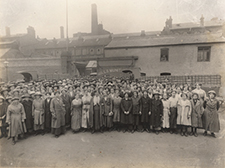On This Day
On This Day, 22 October 1917
On 22, Oct 2017 | In On This Day | By Nicola Gauld
Birmingham Mail
Monday 22 October 1917
WOMEN WAR WORKERS.
EXHIBITION AT THE BIRMINGHAM ART GALLERY
HOW WOMEN PILE UP MUNITIONS.
Under the auspices of the Labour Supply Department of the Ministry of Munitions an exhibition (to remain open for a fortnight) of samples of women’s war work, and official photographs, was opened this afternoon at the Art Gallery by the Lord Mayor of Birmingham. The exhibition is of great interest in a large industrial city like Birmingham, which, since the outbreak of war, has taken a foremost position in the production of war equipment. The various specimens, which fill a couple of galleries, illustrate the various types of work upon which women are employed in engineering and other industries on munitions of war. From a technical and mechanical point of view the exhibition is of special importance; whilst to the general public it will be found to have many absorbing features.
The Air Board has lent a complete Clerget engine, which has been made for the most part by women, and one is able to compare it with two examples of German aeroplane engines—the Mercedes and Benz. The system of standardisation of parts is a feature of the German productions, and it also noteworthy that the enemy pays little regard for fine workmanship in those sections of mechanical equipment which are not of vital concern. Other exhibits include machine guns and service rifles, and examples of German trench and machine guns, whilst the walls are adorned with photographs of “tanks” and all sorts of war equipment, and various processes of manufacture, showing women in the factories.
The exhibition is a revelation as to the great and increasing part which women and girls are playing in the prosecution of the war. To-day they number a million, and the evidences are that that figure will be substantially increased in the near future. Women are shown constructing marina boilers; others are engaged at lathes; and there are pictures showing Birmingham women engaged in the production of tank engine parts, fuses, and cartridge cases. A woman of fifty-five has become an expert at a drilling machine. She took the place of her son, a skilled mechanic, who 18 months ago joined the Army, and is in receipt of over £7 per week. She has not drawn single penny from the firm. “The money is for her son,’’ she declares, “when he returns to ‘Blighty.’” One girl, six months ago a kitchen maid, is depicted in complete control of a thousand bone-power electric generating plant in the Midlands.
In connection with the exhibition, a remarkable series of official films were shown to a meeting at the Scala last night to demonstrate the magnitude of the war work being done in England and France by women. Outside the heavy casting shops and foundries it appears difficult to find a branch of munition work which women are not to-day working in thousands of factories. In the Midlands there are many such instances found, and the photos screened last night included views of local works showing women work. The factory films were supplemented by fine pictures of flights by seaplanes, and manoeuvres by submarines, and an attractive musical programme were followed with considerable interest by a numerous audience of ticket-holders.
The Chairman (Sir W. Ashley) said he regarded the expansion of women’s work during the last three years one of the most marvellous things during the war. Mr. B. H. Morgan (Technical Adviser to the Labour Supply Department, of the Ministry of Munitions) pointed to the remarkable success which had been achieved in enlarging the output of munitions and to the admirable work done by women by a division of various operations. British women were now able to do an enormous variety of machinery and fitting work and to obtain an output which would compare favourably with any class of workers in any country. The way in which women, most them unused to factory life, had adapted themselves to conditions and performed their work was in his opinion, one of the outstanding features of the war. As showing what had been accomplished he mentioned that in connection with aircraft, under the direction of men, women in different shops were now making every part of an aeroplane.



